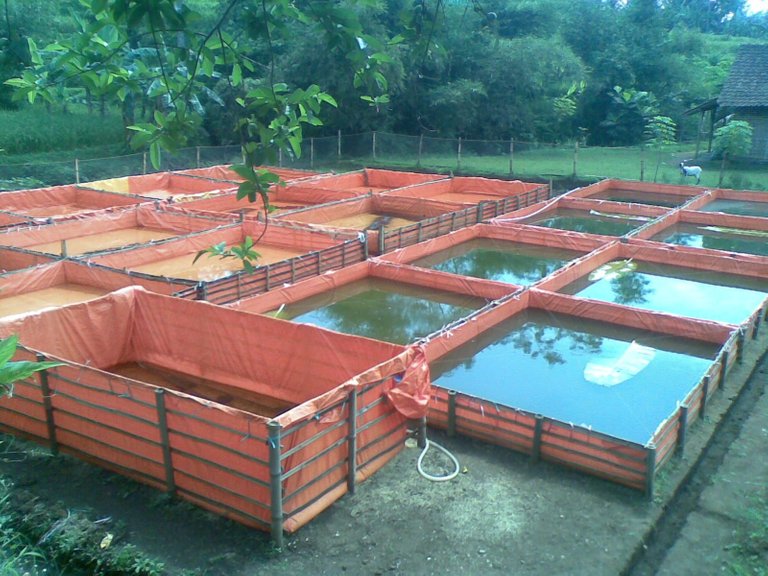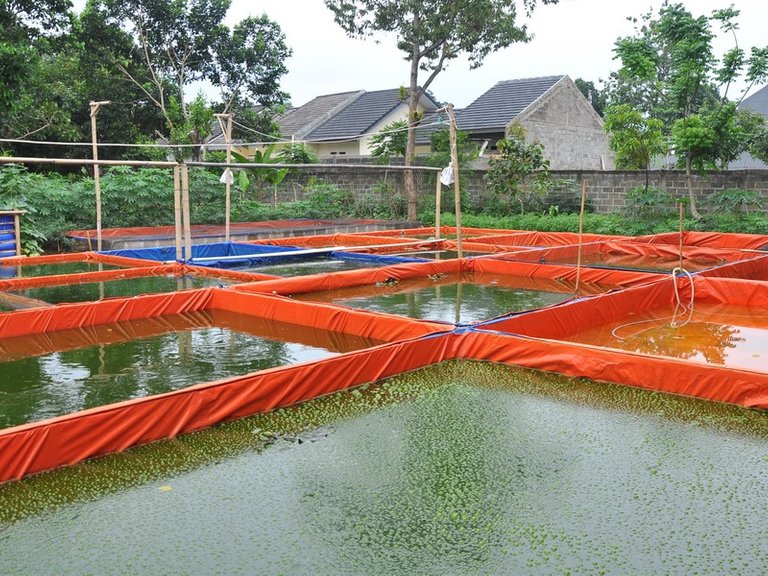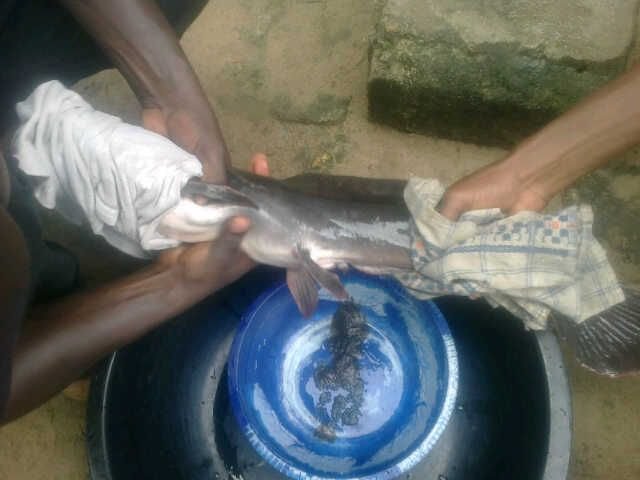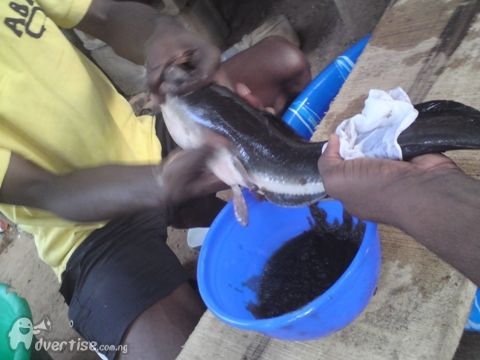

Steps of propagation
Step 1: Identify and separate the sexes.
The male and female of the African catfish can be easily recognized. The male has a distinct sexual papilla, elongated and located just behind the anus. This sexual papilla is usually red at the tip for sexually ready males. It is absent in females.
A gentle press on the belly of the female fish towards the genital opening releases the ripe eggs indicating the readiness and viability of the female.
A sexually ready female has a swollen, usually reddish genital opening. A view from the top also gives a female African catfish away since either side of the belly appears swollen.
Step 2: Select and check for a gravid female ((i.e. female with ripe eggs)
Once you have chosen your female, to detect if the female's egg is ripe enough for propagation. You just have to feel its abdomen by pressing gently, if some fluids flow from the females anus then you are good to go.
Step 3: Weigh the Female Fish
Try and get a dried catfish pituitary gland. Put the pituitary inside a laboratory mortar. Grind the pituitary using a pestle until it becomes powder. Add 1ml saline solution. Collect the solution through an injection and Inject the female fish using an hypodermic Syringe.
OVAPRIM can also be used as a synthetic hormone instead of the natural process.
This is done to have an idea of the weight of the egg inside the fish. From my own experience, I can guess that 8 -15% of the weight of a gravid female fish is the weight of the eggs. A female catfish that therefore weighs 500grams has the weight of the egg to be 50 grams. A gram of egg contains approximately 700 eggs. Thus a gravid female African catfish with a weight of 500grams could boast of 35,000 eggs. The viability of the eggs depends on brood stock care and management.
Step 4: Prepare the female Catfish for injection
Catfish pituitary is commonly used for induced catfish breeding. Methods of removal and preservation of the pituitary are not contained in this book.
For induced breeding of the catfish, I like to the use the pituitary gland, either freshly removed or ethanol preserved. I recommend a ratio of 1:1, recipient: donor i.e. if the weight of the female fish to be induced is 1kg, the weight of the donor fish, male or female should also be 1kg for freshly removed pituitary.
However, for dried, preserved pituitary, I recommend a ratio of 1:1.5 i.e. recipient fish should be 1kg and the donor fish should weigh 1.5kg. I will like to state here that it is not compulsory that the donor fish should be one fish; it could be 2 or 3 fishes with a combined weight of 1.5kg or as the case may be in weight.
A synthetic hormone can also be used. Usually, the manufacturer will include the prescribed dosage suitable for The Catfish breeding.
When you want to inject the fish, please don’t inject the fish on the lateral line. I personally prefer the syringe pointing towards the tail of the fish. The fish should also be injected above the lateral line with the needle at 45 degrees to body of the fish.
Step 5: Injection of the female catfish
When you want to inject the fish, please don’t inject the fish on the lateral line.
I personally prefer the syringe pointing towards the head of the fish. The fish should also be injected above the lateral line with the needle at 45 degrees to body of the fish.
Note that this process should be done while the fish’s head is covered with a moist towel. This allows the fish to remain calm throughout the 18 entire process.
Step 6: Isolate the Injected fish in a Comfortable, big bowl and wait for 10 to 12 hours.
This enables the fish to relax its nerves and take a deep breadth. It's more like when a woman just delivered her baby, she would be either be taken to the post-natal or ante-natal to take a cool rest and breadth. Same process applies to catfishes.
Step 7: Prepare to strip the fish, Set up your incubator.
.jpg)
Step 8: Bring the Fish out after 10 to 12 hours gently and cover the head with a clean, moist towel. Wipe the body of the fish dry using a dry, soft towel. Strip the fish (i.e. press the eggs out of the fish). The pituitary injection makes the fish ready to release the eggs. In fact after the injection has been administered to the fish, following the right dosage, the process of getting the eggs out of the fish is irreversible. When you notice the onset of blood coming out with the eggs, please stop the exercise!



Step 9: Bring the Male out, kill it, turn the belly up and cut it open. Remove the milt sac. Cut the testicles into bits to release the sperm. Add saline solution to the milt. Pour the mixture of saline solution and milt to the stripped eggs in the bowl. Mix thoroughly and add fresh, clean, water. The Saline solution added to the milt (sperm) keeps the sperm alive but not active. The saline solution makes it easy for the entire stripped eggs to be saturated with the milt. The subsequent addition of fresh, clean water now makes the sperm active and motile.
It is the addition of clean water that initiates the external fertilization process. This whole process of fertilization lasts for only about 60 seconds. That is why I strongly advice that you increase percentage fertilization by stirring the mixture during this 60 seconds.
Continue mixing to prevent eggs from sticking together.
Step 10: Spread the eggs inside the incubator on the Spawning sponge. The spawning sponge is completely immersed in water. It however sits on the spawning net which keeps it suspended in the water. The net is held in place by pegs.
Step 18: Wait 20 to 36 hours
After 20 to 36 hours, remove the sponge and spawning net. By now the fry would have emerged from the hatched eggs and would have gone to the bottom of the net.
The un-hatched ones, now attached to the spawning sponge and spawning net are removed from the water since they would be attacked by fungi if left for too long. This fungi would inevitably attack the hatched eggs at the bottom of the net.
Finla step: Observe the newly hatched eggs, with yolk still visible and attached to the fry
I hope i have been able to make impacts by teaching you the artificial processes undergone in catfish propagation/ reproduction.
Kindly upvote, comment and resteem. More articles are going to be posted afterwards about fish lifstyle and productions
Thanks for reading
Hi! I am a robot. I just upvoted you! I found similar content that readers might be interested in:
https://thefishsite.com/articles/19-steps-to-efficient-african-catfish-breeding
yea that's cool
We all need to learn a lot of things.
Thanks